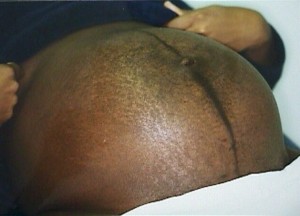Presumptive signs and symptoms of pregnancy are those signs and symptoms that are usually noted by the patient, which impel her to make an appointment with a physician.
These signs and symptoms are not proof of pregnancy but they will make the physician and woman suspicious of pregnancy.
a. Amenorrhea (Cessation of Menstruation).
(1) Amenorrhea is one of the earliest clues of pregnancy. The majority of patients have no periodic bleeding after the onset of pregnancy. However, at least 20 percent of women have some slight, painless spotting during early gestation for no apparent reason and a large majority of these continue to term and have normal infants.
(2) Other causes for amenorrhea must be ruled out, such as:
(a) Menopause.
(b) Stress (severe emotional shock, tension, fear, or a strong desire for a pregnancy).
(c) Chronic illness (tuberculosis, endocrine disorders, or central nervous system abnormality).
(d) Anemia.
(e) Excessive exercise.
b. Nausea and Vomiting (Morning Sickness).
(1) Usually occurs in early morning during the first weeks of pregnancy.
(2) Usually spontaneous and subsides in 6 to 8 weeks or by the twelfth to sixteenth week of pregnancy.
(3) Hyperemesis gravidarum. This is referred to as nausea and vomiting that is severe and lasts beyond the fourth month of pregnancy. It causes weight loss and upsets fluid and electrolyte balance of the patient.
(4) Nausea and vomiting are unreliable signs of pregnancy since they may result from other conditions such as:
(a) Gastrointestinal disorders (hiatal hernias, ulcers, and appendicitis).
(b) Infection (influenza and encephalitis).
(c) Emotional stress, upset (anxiety and anorexia nervosa).
(d) Indigestion.
c. Frequent Urination.
(1) Frequent urination is caused by pressure of the expanding uterus on the bladder.
(2) It subsides as pregnancy progresses and the uterus rises out of the pelvic cavity.
(3) The uterus returns during the last weeks of pregnancy as the head of the fetus presses against the bladder.
(4) Frequent urination is not a definite sign since other factors can be apparent (such as tension, diabetes, urinary tract infection, or tumors).
d. Breast Changes.
(1) In early pregnancy, changes start with a slight, temporary enlargement of the breasts, causing a sensation of weight, fullness, and mild tingling.

(2) As pregnancy continues the patient may notice:
(a) Darkening of the areola–the brown part around the nipple.
(b) Enlargement of Montgomery glands–the tiny nodules or sebaceous glands within the areola.
(c) Increased firmness or tenderness of the breasts.
(d) More prominent and visible veins due to the increased blood supply.
(e) Presence of colostrum (thin yellowish fluid that is the precursor of breast milk). This can be expressed during the second trimester and may even leak outin the latter part of the pregnancy.
(3) These breast changes can be more positive if the patient has not recently delivered and is not presently breastfeeding.
e. Vaginal Changes.
(1) Chadwick’s sign. The vaginal walls have taken on a deeper color caused by the increased vascularity because of increased hormones. It is noted at the sixth week when associated with pregnancy. It may also be noted with a rapidly growing uterine tumor or any cause of pelvic congestion.
(2) Leukorrhea. This is an increase in the white or slightly gray mucoid discharge that has a faint musty odor. It is due to hyperplasia of vaginal epithelial cells of the cervix because of increased hormone level from the pregnancy. Leukorrhea is also present in vaginal infections.
f. Quickening (Feeling of Life).
(1) This is the first perception of fetal movement within the uterus. It usually occurs toward the end of the fifth month because of spasmodic flutter.
(a) A multigravida can feel quickening as early as 16 weeks.
(b) A primigravida usually cannot feel quickening until after 18 weeks.
(2) Once quickening has been established, the patient should be instructed to report any instance in which fetal movement is absent for a 24-hour period.
(3) Fetal movement early in pregnancy is frequently thought to be gas.
g. Skin Changes.
(1) Striae gravidarum (stretch marks). These are marks noted on the abdomen and/or buttocks.
(a) These marks are caused by increased production or sensitivity to adrenocortical hormones during pregnancy, not just weight gain.
(b) These marks may be seen on a patient with Cushing’s disease or a patient with sudden weight gain.
(2) Linea nigra.
(a) This is a black line in the midline of the abdomen that may run from the sternum or umbilicus to the symphysis pubis.

(b) This appears on the primigravida by the third month and keeps pace with the rising height of the fundus.
(c) The entire line may appear on the multigravida before the third month.
(d) This may be a probable sign if the patient has never been pregnant.
(3) Chloasma. This is called the “Mask of Pregnancy.” It is a bronze type of facial coloration seen more on dark-haired women. It is seen after the sixteenth week of pregnancy.
(4) Fingernails. Some patients note marked thinning and softening by the sixth week.
h. Fatigue. This is a common complaint by most patients during the first trimester. Fatigue may also be a result of anemia, infection, emotional stress, or malignant disease.
i. Positive Home Test. These tests may not always be accurate, however, they are very effective today if they are performed properly.
